The Effect of Sulfur Carriers on Nitrogen Use Efficiency in Potatoes—A Case Study
Abstract
1. Introduction
2. Materials and Methods
2.1. Experiment Description
2.2. Weather Conditions
2.3. Experimental Design
- (A)
- Sulfur fertilization (SF):
- (1)
- Control (without S fertilization);
- (2)
- Elemental sulfur (S0);
- (3)
- Calcium sulfate (CS).
- (B)
- Nitrogen fertilization level (NF): 0, 30, 60, 90, 120, and 150 kg N·ha−1.
2.4. Sampling of Plant Material and Chemical Analysis
2.5. Calculated Indicators
- D—Nitrogen dose (kg N·ha−1);
- TYN—Yield of fertilized plants (kg·ha−1);
- TYc—Yield of plants from the control (not fertilized) (kg·ha−1);
- TU-NN—Total nitrogen uptake by fertilized plants (kg N·ha−1);
- TU-Nc—Total nitrogen uptake by plants from the control (not fertilized) (kg N·ha−1).
- TY—Tuber yield (t·ha−1);
- TU-N—Total nitrogen uptake (kg·ha−1);
- TU-S—Total sulfur uptake (kg·ha−1);
- TU-Ca—Total calcium uptake (kg·ha−1).
2.6. Path Analysis
2.7. Statistical Calculations
3. Results
3.1. Yield and Yield Structure
3.2. Nitrogen Efficiency Indicators
3.3. Accumulation of Nitrogen, Calcium, and Sulfur
3.4. Linking Yield to Nutrient Accumulation
4. Discussion
4.1. Influence of Experimental Factors on Yield Effects
4.2. Nitrogen Management
4.3. Relationship between Nitrogen Accumulation and the Accumulation of Sulfur and Calcium
5. Conclusions
Author Contributions
Funding
Data Availability Statement
Conflicts of Interest
Appendix A
| Year | FY 0–35 | FY 36–50 | FY 51–60 | FY 60< | |
|---|---|---|---|---|---|
| 2012 | TY | 0.19 | −0.09 | 0.57 ** | 0.66 ** |
| FY 0–35 | 1.00 | 0.01 | −0.16 | 0.11 | |
| FY 36–50 | 1.00 | −0.06 | −0.63 ** | ||
| FY 51–60 | 1.00 | 0.01 | |||
| 2013 | TY | −0.03 | 0.06 | 0.36 | 0.94 *** |
| FY 0–35 | 1.00 | −0.03 | 0.41 | −0.24 | |
| FY 36–50 | 1.00 | 0.38 | −0.20 | ||
| FY 51–60 | 1.00 | 0.04 | |||
| 2014 | TY | 0.47 * | 0.76 *** | 0.76 *** | 0.73 *** |
| FY 0–35 | 1.00 | 0.62 ** | 0.09 | 0.11 | |
| FY 36–50 | 1.00 | 0.51 * | 0.22 | ||
| FY 51–60 | 1.00 | 0.39 |
| Year | Indicator | Factor | Mean for Year | ||
|---|---|---|---|---|---|
| Control | S0 | CS | |||
| 2012 | x (t∙ha−1) | 49.7 | 51.9 | 53.2 | 51.6 |
| SD (t∙ha−1) | 5.30 | 2.22 | 2.47 | 3.71 | |
| V (%) | 10.7 | 4.3 | 4.6 | 7.2 | |
| Min. (t∙ha−1) | 40.6 | 50.0 | 50.0 | 40.6 | |
| Max. (t∙ha−1) | 55.7 | 56.3 | 57.0 | 57.0 | |
| 2013 | x (t∙ha−1) | 48.0 | 50.8 | 51.0 | 49.9 |
| SD (t∙ha−1) | 10.28 | 11.31 | 10.60 | 10.18 | |
| V (%) | 21.4 | 22.3 | 20.8 | 20.4 | |
| Min. (t∙ha−1) | 28.7 | 30.2 | 30.8 | 28.7 | |
| Max. (t∙ha−1) | 56.2 | 59.6 | 57.8 | 59.6 | |
| 2014 | x (t∙ha−1) | 39.4 | 43.2 | 42.4 | 41.7 |
| SD (t∙ha−1) | 6.13 | 4.82 | 4.42 | 5.15 | |
| V (%) | 15.6 | 11.2 | 10.4 | 12.4 | |
| Min. (t∙ha−1) | 28.5 | 34.3 | 33.7 | 28.5 | |
| Max. (t∙ha−1) | 46.2 | 47.7 | 45.3 | 47.7 | |
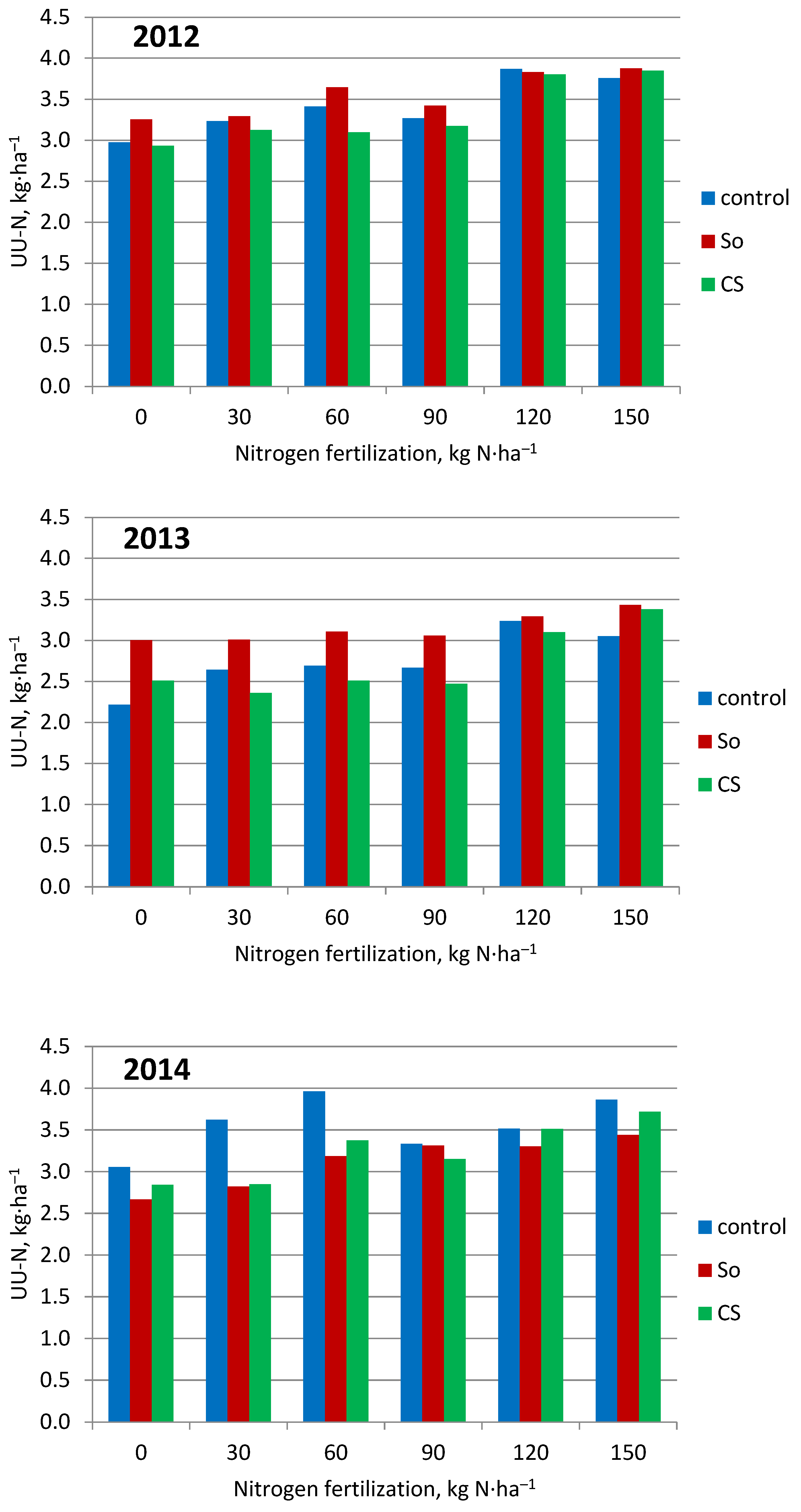
References
- Camire, M.E.; Kubow, S.; Donnelly, D.J. Potatoes and human health. Crit. Rev. Food Sci. Nutr. 2009, 49, 823–840. [Google Scholar] [CrossRef]
- Zaheer, K.; Akhtar, M.H. Potato Production, Usage, and Nutrition—A Review. Crit. Rev. Food Sci. Nutr. 2016, 56, 711–721. [Google Scholar] [CrossRef]
- Devaux, A.; Kromann, P.; Ortiz, O. Potatoes for Sustainable Global Food Security. Potato Res. 2014, 57, 185–199. [Google Scholar] [CrossRef]
- Burgos, G.; Zum Felde, T.; Andre, C.; Kubow, S. The Potato and Its Contribution to the Human Diet and Health. In The Potato Crop; Campos, H., Ortiz, O., Eds.; Springer: Cham, Switzerland, 2020; pp. 37–74. [Google Scholar]
- Naumann, M.; Koch, M.; Thiel, H.; Gransee, A.; Pawelzik, E. The Importance of Nutrient Management for Potato Production Part II: Plant Nutrition and Tuber Quality. Potato Res. 2020, 63, 121–137. [Google Scholar] [CrossRef]
- Ahmadu, T.; Abdullahi, A.; Ahmad, K.; Ahmadu, T.; Abdullahi, A.; Ahmad, K. The Role of Crop Protection in Sustainable Potato (Solanum tuberosum L.) Production to Alleviate Global Starvation Problem: An Overview. In Solanum tuberosum—A Promising Crop for Starvation Problem; Yildiz, M., Ozgen, Y., Eds.; IntechOpen Limited: London, UK, 2021; pp. 1–33. [Google Scholar]
- Reyniers, S.; Ooms, N.; Gomand, S.; Delcour, J.A. What makes starch from potato (Solanum tuberosum L.) tubers unique: A review. Compr. Rev. Food Sci. Food Saf. 2020, 19, 2588–2612. [Google Scholar] [CrossRef]
- Potarzycki, J. Balanced Fertilization and the Use of Plant Potential; PWRiL: Warszawa, Poland, 2017; pp. 1–143. (In Polish) [Google Scholar]
- Schafleitner, R.; Gutierrez, R.; Espino, R.; Gaudin, A.; Pérez, J.; Martínez, M.; Domínguez, A.; Tincopa, L.; Alvarado, C.; Numberto, G.; et al. Field Screening for Variation of Drought Tolerance in Solanum tuberosum L. by Agronomical, Physiological and Genetic Analysis. Potato Res. 2007, 50, 71–85. [Google Scholar] [CrossRef]
- Adekanmbi, T.; Wang, X.; Basheer, S.; Nawaz, R.A.; Pang, T.; Hu, Y.; Liu, S. Assessing Future Climate Change Impacts on Potato Yields—A Case Study for Prince Edward Island, Canada. Foods 2023, 12, 1176. [Google Scholar] [CrossRef]
- Grzebisz, W.; Frackowiak, K.; Spiżewski, T.; Przygocka-Cyna, K. Does Elemental Sulfur Act as an Effective Measure to Control the Seasonal Growth Dynamics of Potato Tubers (Solanum tuberosum L.)? Plants 2022, 11, 248. [Google Scholar] [CrossRef]
- Kulczycki, G. The effect of elemental sulfur fertilization on plant yields and soil properties. Adv. Agron. 2021, 167, 105–181. [Google Scholar]
- Przygocka-Cyna, K.; Biber, M.; Pluta, M.; Grzebisz, W. Mineral density of onion bulbs as affected by fertilizers based on elemental sulfur. J. Elem. 2016, 21, 485–499. [Google Scholar] [CrossRef]
- Kairies, C.L.; Schroeder, K.T.; Cardone, C.R. Mercury in gypsum produced from flue gas desulfurization. Fuel 2006, 85, 2530–2536. [Google Scholar] [CrossRef]
- Watts, D.B.; Dick, W.A. Sustainable Uses of FGD Gypsum in Agricultural Systems: Introduction. J. Environ. Qual. 2014, 43, 246–252. [Google Scholar] [CrossRef] [PubMed]
- Grzebisz, W.; Zielewicz, W.; Przygocka-Cyna, K. Deficiencies of Secondary Nutrients in Crop Plants—A Real Challenge to Improve Nitrogen Management. Agronomy 2023, 13, 66. [Google Scholar] [CrossRef]
- Toma, M.; Sumner, M.E.; Weeks, G.; Saigusa, M. Long-term Effects of Gypsum on Crop Yield and Subsoil Chemical Properties. Soil Sci. Soc. Am. J. 1999, 63, 891–895. [Google Scholar] [CrossRef]
- Potarzycki, J.; Przygocka-Cyna, K.; Wendel, J.; Biniek, Ł.; Ridiger, B. The impact of Sulphur fertilization on yield of winter wheat. Fragm. Agron. 2015, 32, 63–72. [Google Scholar]
- Zielewicz, W.; Swędrzyńska, D.; Swędrzyński, A.; Grzebisz, W.; Goliński, P. The Influence of Calcium Sulfate and Different Doses of Potassium on the Soil Enzyme Activity and the Yield of the Sward with a Mixture of Alfalfa and Grasses. Agriculture 2022, 12, 475. [Google Scholar] [CrossRef]
- Frąckowiak, K.; Potarzycki, J.; Grzebisz, W.; Szczepaniak, W. Potato nutritional status at the onset of tuberisation—A yield prediction tool. Plant Soil Environ. 2020, 66, 86–92. [Google Scholar] [CrossRef]
- Grzebisz, W.; Potarzycki, J. The in-season nitrogen concentration in the potato tuber as the yield driver. Agron J. 2020, 112, 1287–1308. [Google Scholar] [CrossRef]
- Hlisnikovský, L.; Menšík, L.; Kunzová, E. The Effect of Soil-Climate Conditions, Farmyard Manure and Mineral Fertilizers on Potato Yield and Soil Chemical Parameters. Plants 2021, 10, 2473. [Google Scholar] [CrossRef]
- Blecharczyk, A.; Kowalczewski, P.Ł.; Sawinska, Z.; Rybacki, P.; Radzikowska-Kujawska, D. Impact of Crop Sequence and Fertilization on Potato Yield in a Long-Term Study. Plants 2023, 12, 495. [Google Scholar] [CrossRef]
- Klikocka, H.; Sachajko, J. Influence of sulphur fertilization on commercial and seed tuber yield of potato. Acta Agrophysica 2007, 10, 383–396. (In Polish) [Google Scholar]
- Sharma, D.K.; Kushwah, S.S.; Nema, P.K.; Rathore, S.S. Effect of Sulphur on Yield and Quality of Potato (Solanum tuberosum L.). Int. J. Agric. Res. 2011, 6, 143–148. [Google Scholar] [CrossRef]
- Potarzycki, J.; Grzebisz, W. The in-season variability in the calcium concentration in potato organs and its relationship with the tuber yield. J. Elem. 2020, 25, 107–124. [Google Scholar] [CrossRef]
- Bloem, E.; Haneklaus, S.; Schnug, E. Milestones in plant sulfur research on sulfur-resistance (SIR) in Europe. Front. Plant Sci. 2015, 5, 779. [Google Scholar] [CrossRef]
- Brennan, R.F.; Bolland, M.D.A. Significant Nitrogen by Sulfur Interactions Occurred for Canola Grain Production and Oil Concentration in Grain on Sandy Soils in the Mediterranean-Type Climate of Southwestern Australia. J. Plant Nutr. 2008, 31, 1174–1187. [Google Scholar] [CrossRef]
- Salviagotti, F.; Castellalrin, J.M.; Miralles, D.J.; Pedrol, H.M. Sulfur fertilization improves nitrogen use efficiency in wheat by increasing nitrogen uptake. Field Crops Res. 2009, 113, 170–177. [Google Scholar] [CrossRef]
- Szulc, P.; Bocianowski, J.; Rybus-Zając, M. The effect of soil supplentation with nitrogen and elemental sulfur on chlorphyll content and grain yield of maize (Zea mays L.). Zemdirb. Agric. 2012, 99, 247–254. [Google Scholar]
- Fageria, N.K.; Baligar, V.C.; Li, Y.C. The Role of Nutrient Efficient Plants in Improving Crop Yields in the Twenty First Century. J. Plant Nutr. 2008, 31, 1121–1157. [Google Scholar] [CrossRef]
- Lombardo, S.; Pandino, G.; Mauromicale, G. Optimizing nitrogen fertilization to improve qualitative performances and physiological and yield responses of potato (Solanum tuberosum L.). Agronomy 2020, 10, 352. [Google Scholar] [CrossRef]
- Grzebisz, W.; Diatta, J.; Barłóg, P.; Biber, M.; Potarzycki, J.; Łukowiak, R.; Przygocka-Cyna, K.; Szczepaniak, W. Soil Fertility Clock—Crop Rotation as a Paradigm in Nitrogen Fertilizer Productivity Control. Plants 2022, 11, 2841. [Google Scholar] [CrossRef]
- Fontes, P.C.R.; Braun, H.; Busato, C.; Cecon, P.R. Economic Optimum Nitrogen Fertilization Rates and Nitrogen Fertilization Rate Effects on Tuber Characteristics of Potato Cultivars. Potato Res. 2010, 53, 167–179. [Google Scholar] [CrossRef]
- Kołodziejczyk, M. Effect of nitrogen fertilization and microbial preparations on potato yielding. CAAS Agric. J. 2014, 60, 379–386. [Google Scholar] [CrossRef]
- Anning, D.K.; Ghanney, P.; Qiu, H.; Zhang, C.; Zhang, Y. Agronomic and Physiological Response of Potato (Solanum tuberosum L.) to Nitrogen Fertilization Rate on a Loess Soil of Northwest China. Potato Res. 2023, 66, 621–640. [Google Scholar] [CrossRef]
- Anas, M.; Liao, F.; Verma, K.K.; Sarwar, M.A.; Mahmood, A.; Chen, Z.-L.; Li, Q.; Zeng, X.-P.; Liu, Y.; Li, Y.-R. Fate of nitrogen in agriculture and environment: Agronomic, eco-physiological and molecular approaches to improve nitrogen use efficiency. Biol. Res. 2020, 53, 47. [Google Scholar] [CrossRef] [PubMed]
- Sharma, L.K.; Bali, S.K. A review of methods to improve nitorgen use efficiency in agriculture. Sustainability 2018, 10, 51. [Google Scholar] [CrossRef]
- Ierna, A.; Mauromicale, G. Sustainable and Profitable Nitrogen Fertilization Management of Potato. Agronomy 2019, 9, 582. [Google Scholar] [CrossRef]
- Grzebisz, W.; Łukowiak, R.; Sassenrath, G.F. Virtual nitrogen as a tool for assessment of nitrogen management at the field scale: A crop rotation approach. Field Crops Res. 2018, 218, 182–194. [Google Scholar] [CrossRef]
- Grzebisz, W.; Łukowiak, R. Nitrogen Gap Amelioration is a Core for Sustainable Intensification of Agriculture—A Concept. Agronomy 2021, 11, 419. [Google Scholar] [CrossRef]
- White, A.C.; Rogers, A.; Rees, M.; Osborne, C.P. How can we make plants grow faster? A source-sink perspective on growth rate. J. Exp. Bot. 2016, 67, 31–45. [Google Scholar] [CrossRef]
- Grzebisz, W.; Frąckowiak, K.; Potarzycki, J.; Diatta, J.; Szczepaniak, W. The Unexploited Potential of Nutrient Analysis in Potato Tissues at the Onset of Tuberization for Tuber Yield Prediction. Agronomy 2020, 10, 103. [Google Scholar] [CrossRef]
- Potarzycki, J.; Grzebisz, W. Trends in phosphorus concentrations in potato organs during the growing season. J. Elem. 2019, 24, 935–952. [Google Scholar] [CrossRef]
- Thor, K. Calcium–Nutrient and messenger. Front. Plant Sci. 2019, 10, 440. [Google Scholar] [CrossRef] [PubMed]
- Nibou, C.; Gibbs, D.J.; Coates, J.C. Branching out in new directions: The control of root architecture by lateral root formation. New Phytol. 2008, 179, 595–614. [Google Scholar] [CrossRef] [PubMed]
- Steffens, B.; Rasmussen, A. The physiology of adventitious roots. Plant Physiol. 2016, 170, 603–617. [Google Scholar] [CrossRef] [PubMed]
- Scherer, H.W. Sulphur in crop production—Invited paper. Eur. J. Agron. 2001, 14, 81–111. [Google Scholar] [CrossRef]
- Grant, C.; Hawkesford, M.J. Handbook of Plant Nutrition, 2nd ed.; Sulfur, W., Barker, A.V., Pilbeam, D.J., Eds.; Wyd. CRC Press Taylor & Francis Group: Boca Raton, FL, USA; London, UK; New York, NY, USA, 2015; pp. 261–302. [Google Scholar]
- White, P.J.; Broadley, M.R. Calcium in Plants. Ann. Bot. 2003, 92, 487–511. [Google Scholar] [CrossRef]
- Kabała, C.; Charzynski, P.; Chodorowski, J.; Drewnik, M.; Glina, B.; Greinert, A.; Hulisz, P.; Jankowski, M.; Jonczak, J.; Łabaz, B.; et al. Polish Soil Classification: Principles, classification scheme and correlation. Soil Sci. Annu. 2019, 70, 71–97. [Google Scholar] [CrossRef]
- Konys, L.; Wiśniewski, P. Path analysis in cause and effect relationships. Rocz. Akad. Rol. W Pozn. 1984, CLIII, 37–54. (In Polish) [Google Scholar]
- Pandey, N. Role of Plant Nutrients in Plant Growth and Physiology. In Plant Nutrients and Abiotic Stress Tolerance; Hasanuzzaman, M., Fujita, M., Oku, H., Nahar, K., Hawrylak-Nowak, B., Eds.; Springer: Singapore, 2018; pp. 51–93. [Google Scholar]
- Koch, M.; Naumann, M.; Pawelzik, E.; Gransee, A.; Thiel, E. The importance of nutrient management for potato production. Part I: Plant Nutrition and yield. Potato Res. 2020, 63, 97–119. [Google Scholar] [CrossRef]
- Begum, M.; Saikia, M.; Sarmah, A.; Ojah, N.J.; Deka, P.; Dutta, P.K.; Ojah, I. Water Management for Higher Potato Production: A Review. Int. J. Curr. Microbiol. App. Sci. 2018, 7, 24–33. [Google Scholar] [CrossRef]
- O’Brien, P.J.; Allen, E.J.; Firman, D.M. A review of some studies into tuber initiation in potato (Solanum tuberosum) crops. J. Agric. Sci. Camb. 1998, 130, 251–270. [Google Scholar] [CrossRef]
- Wright, J.; Stark, J. Potato. In Irrigation of Agricultural Crops; Agronomy Monograph; ASA-CSSASSSA: Madison, WI, USA, 1990; pp. 859–888. [Google Scholar]
- Trawczyński, C. Yield and quality of potato tubers as affected by fertilisation involving the use of soil-incorporated and foliar commercial fertilizer products. Acta Agrophysica 2006, 23, 261–273. (In Polish) [Google Scholar]
- Rębarz, K. The Influence of Sprinkling Irrigation, Methods of Accelerating Emergence and Nitrogen Fertilization on the Yield and Quality of very Early Potato Tubers; UP: Poznań, Poland, 2013; pp. 5–91. (In Polish) [Google Scholar]
- Cohan, J.P.; Hannon, C.; Houilliez, B.; Gravoueille, J.M.; Geille, A.; Lampaert, E.; Laurent, F. Effects of Potato Cultivar on the Components of Nitrogen Use Efficiency. Potato Res. 2018, 61, 231–246. [Google Scholar] [CrossRef]
- White, P.J. Calcium. In Handbook of Plant Nutrition, 2nd ed.; Barker, A.V., Pilbeam, D.J., Eds.; CRC Press, Taylor and Francis Group: Bocan Raton, FL, USA, 2015; pp. 165–198. [Google Scholar]
- Skwierawska, M.; Zawartka, L.; Zawadzki, B. The effect of different rates and forms of sulphur applied on changes of soil agrochemical properties. Plant Soil Environ. 2008, 54, 171–177. [Google Scholar] [CrossRef]
- Germida, J.; Janzen, H. Factors affecting the oxidation of element al sulfur in soils. Nutr. Cycling Agroecosyst. 1993, 35, 101–114. [Google Scholar]
- Kołwzan, B.; Adamiak, W.; Grabas, K.; Pawełczyk, A. Podstawy Mikrobiologii w Ochronie Środowiska; Oficyna Wydawnicza Politechniki Wrocławskiej: Wrocław, Poland, 2005; p. 117. [Google Scholar]
- Aulakh, M.S.; Singh, B.; Arora, B.R. Effect of Sulphur Fertilization on the Yield and Quality of Potatoes (Solanum tuberosum L.). J. Indian Soc. Soil Sci. 1977, 25, 182–185. [Google Scholar]
- Sud, K.C.; Sharma, R.C.; Verma, B.C. Evaluation of levels and sources of sulphur on potato nutrition in Shimla hills. J. Indian Potato Assoc. 1996, 23, 134–138. [Google Scholar]
- Klikocka, H. Fertilization of potatoes with sulfur. Fragm. Agron. 2004, 21, 80–94. (In Polish) [Google Scholar]
- Singh, D.P.; Seema, A.J.; Singh, S.P.; Singh, V. Effect of Sulphur on yield, uptake of nutrients and economics of garlic (Allium sativum), onion (Allium cepa) and potato (Solanum tuberosum) in alluvial soil. Indian J. Agric. Sci. 2016, 86, 661–665. [Google Scholar] [CrossRef]
- Sanli, A.; Tongucz, M.; Tosun, B.; Cirit, Y. Sulphur application methods and dose affects potato (Solanum tuberosum L.) tuber yield and quality. Fresenius Environ. Bull. 2022, 31, 1756–1768. [Google Scholar]
- Zoca, S.M.; Penn, C. An Important Tool with No Instruction Manual: A Review of Gypsum Use in Agriculture, Editor: Sparks, D.L. Adv. Agron. 2017, 144, 1–44. [Google Scholar]
- Marschner, P. (Ed.) Marchnerr’s Mineral Nutrition of Higher Plants, 3rd ed.; Academic Press: London, UK, 2012; p. 672. [Google Scholar]
- Guntiñas, M.E.; Leirós, M.C.; Trasar-Cepeda, C.; Gil-Sotres, F. Effects of moisture and temperature on net soil nitrogen mineralization: A laboratory study. Eur. J. Soil Biol. 2012, 48, 73–80. [Google Scholar] [CrossRef]
- Penn, C.J.; Camberato, J.J. A critical review on soil chemical processes that control how soil pH affects phosphorus availability to plants. Agriculture 2019, 9, 120. [Google Scholar] [CrossRef]
- Palta, J.P. Improving Potato Tuber Quality and Production by Targeted Calcium Nutrition: The Discovery of Tuber Roots Leading to a New Concept in Potato Nutrition. Potato Res. 2010, 53, 267–275. [Google Scholar] [CrossRef]
- Löhnis, F. Nitrogen availability of green manures. Soil Sci. 1926, 22, 253–290. [Google Scholar] [CrossRef]
- Kuzyakov, Y.; Friedel, J.K.; Stahr, K. Review of mechanisms and quantification of priming effects. Soil Biol. Biochem. 2000, 32, 1485–1498. [Google Scholar] [CrossRef]
- Mackintosh, M.E. Nitrogen Fixation by Thiobacillus ferrooxidans. J. Gen. Microbiol. 1978, 105, 215–218. [Google Scholar] [CrossRef]
- Barczak, B.; Nowak, K. Effect of sulphur fertilisation on the content of macroelements and their ionic ratios in potato tubers. J. Elem. 2015, 20, 37–47. [Google Scholar] [CrossRef]
- Perdele, E. A Study on Effect of Calcium-Magnesium-Phosphorus Fertilizer on Potato Tubers (Solanum tuberosum L.) and Physiological Properties of Potato Flour during Storage; Civillier Verlag: Geottingen, Germany, 2005; pp. 1–132. [Google Scholar]
- Tzeng, K.C.; Micguire, R.G.; Kelman, A. Resistance of tubers from different potato cultivars to soft rot caused by Erwinia carotovora subsp. atroseptica. Am. Potato J. 1990, 67, 287–305. [Google Scholar] [CrossRef]
- Brown, C.R.; Haynes, K.G.; Moore, M.; Pavek, M.J.; Hane, D.C.; Love, S.L.; Novy, R.G.; Miller, J.C., Jr. Stability and broad-sense heritability of mineral content in potato: Calcium and magnesium. Am. J. Pot. Res. 2013, 89, 255–261. [Google Scholar] [CrossRef][Green Version]
- Klikocka, H. Influence of NPK fertilization enriched with S, Mg and micronutrients contained in liquid fertilizer indol 7 on potato tubers yield (Solanum tuberosum L.) and infestation of tubers with Streptomyces scabies and Rhizoctonia solani. J. Elem. 2009, 14, 271–288. [Google Scholar]
- Grzebisz, W. Technology of Crop Plants Fertilization–Yield Physiology. Part II. Oil, Roots, Legumes; PWRiL: Poznań, Poland, 2011; pp. 1–414. (In Polish) [Google Scholar]
- Westermann, D.T. Nutritional requirements of potatoes. Am. J. Potato Res. 2005, 82, 301–307. [Google Scholar] [CrossRef]
- Hájek, M.; Jiménez-Alfaro, B.; Hájek, O.; Brancaleoni, L.; Cantonati, M.; Carbognani, M.; Dedi’c, A.; Dítě, D.; Gerdol, R.; Hájková, P.; et al. A European map of groundwater pH and calcium. Earth Syst. Sci. 2021, 13, 1089–1105. [Google Scholar] [CrossRef]

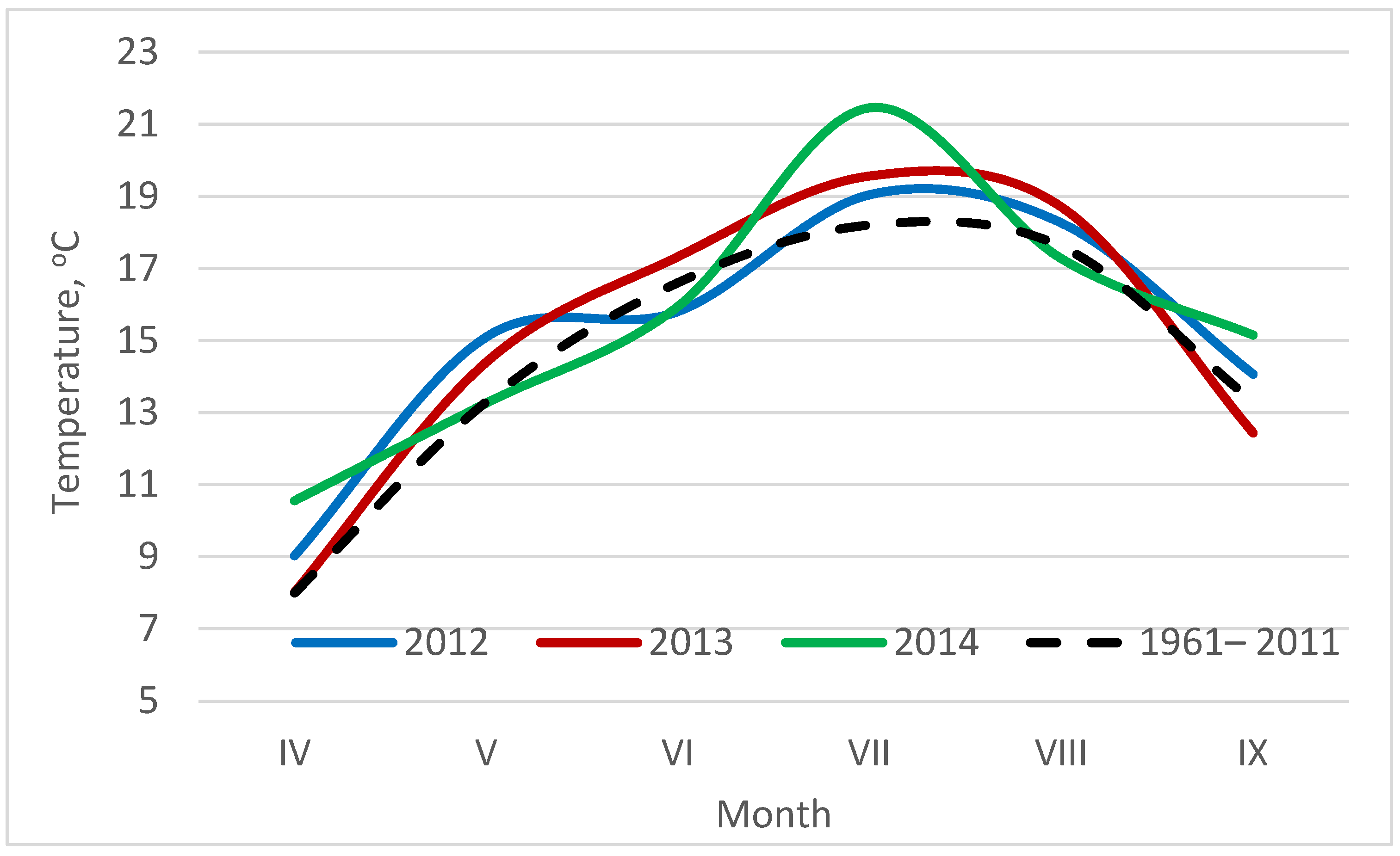

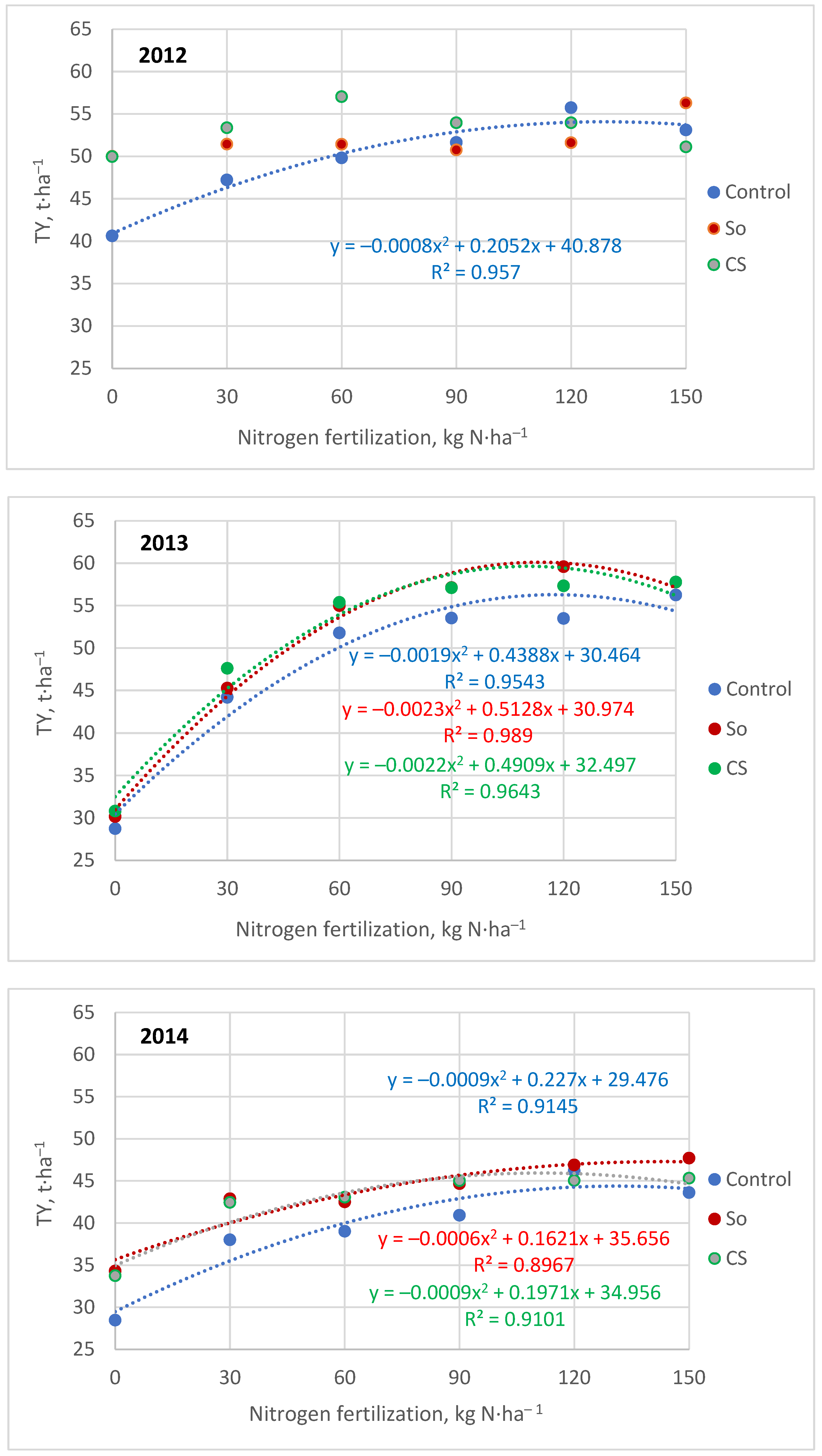
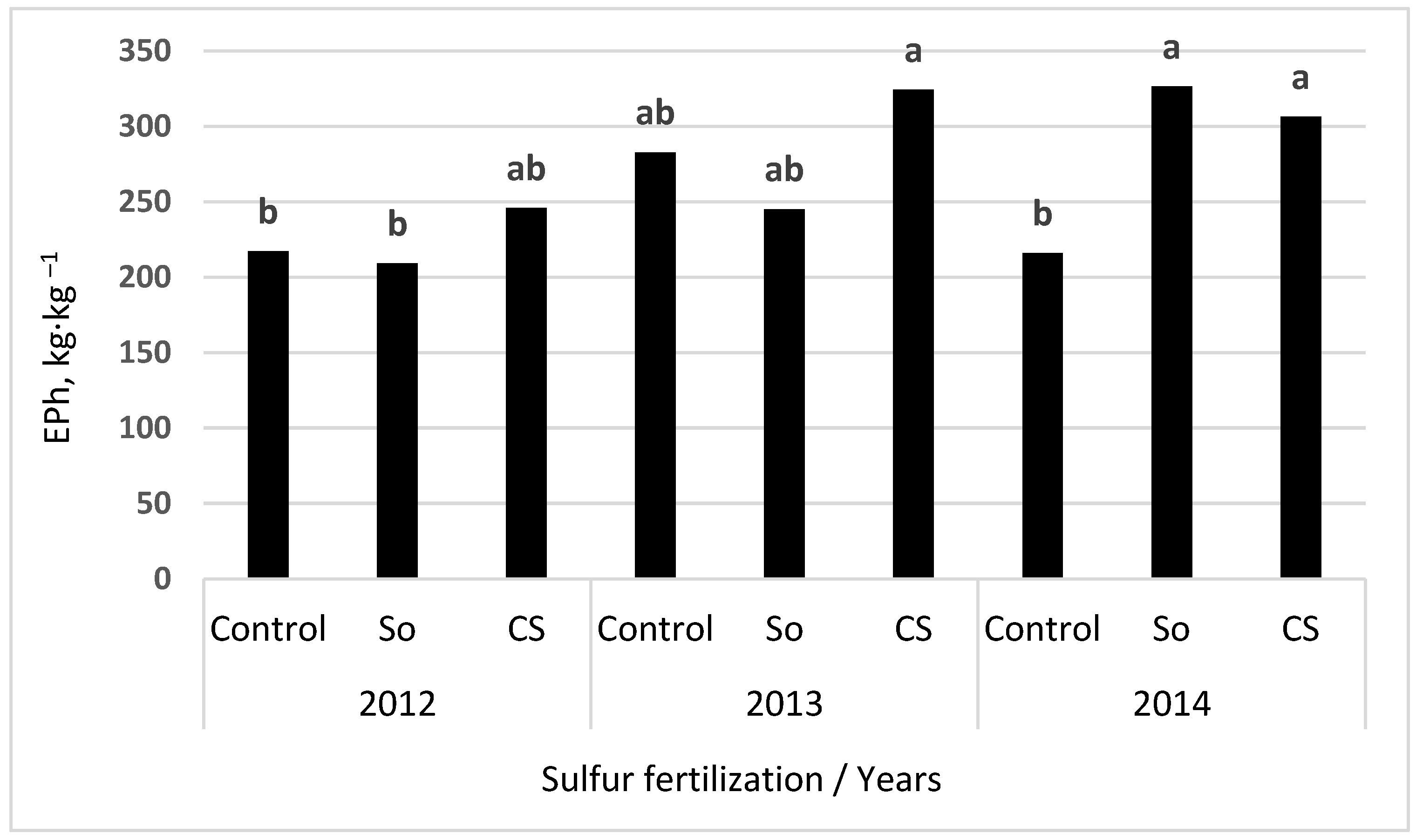




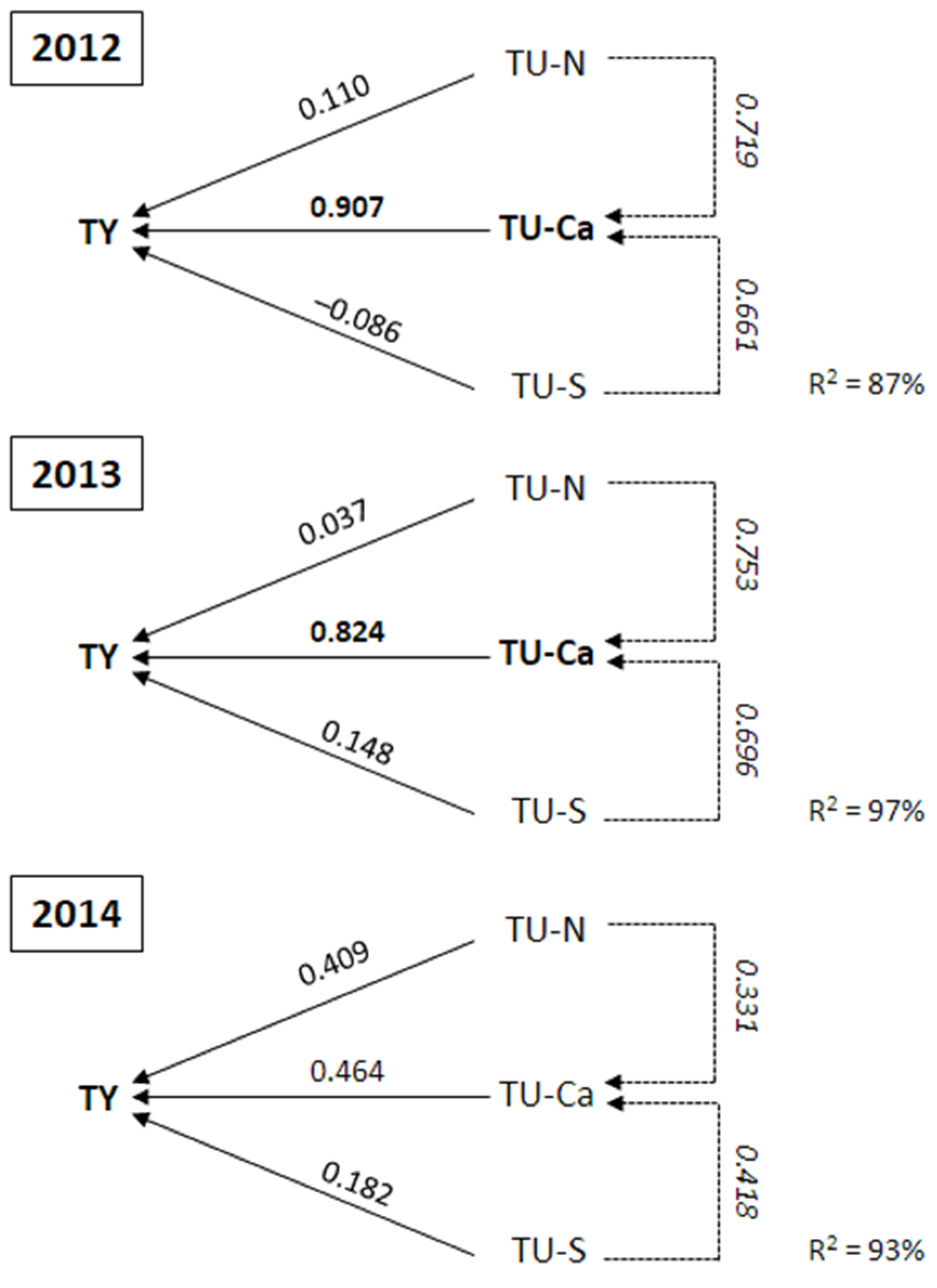
| Soil Property | 2012 | 2013 | 2014 |
|---|---|---|---|
| pH (1 M KCl) | 5.8 | 5.9 | 5.8 |
| Nmin (kg∙ha−1) I/ | 46 | 51 | 56 |
| Available P (mg P·kg−1) II/ | 50 M V/ | 57 M | 53 M |
| Available K (mg K·kg−1) II/ | 112 M | 116 M | 116 M |
| Available Mg (mg Mg·kg−1) III/ | 81 VH | 80 VH | 85 VH |
| Sulfur S-SO4 (mg S·kg−1) IV/ | 9.0 L | 11.5 L | 11.1 L |
| Organic carbon (g·kg−1) | 9.9 | 10.9 | 11.3 |
| Factor | Level of Factor | Total Yield TY (t·ha−1) | Yield in Fraction FY (mm) | |||
|---|---|---|---|---|---|---|
| 0–35 | 36–50 | 51–60 | 60< | |||
| t·ha−1 | ||||||
| Year (Y) | 2012 | 51.61 a | 3.12 b | 10.41 b | 21.78 a | 16.30 b |
| 2013 | 49.94 b | 1.97 c | 9.80 b | 11.27 c | 26.90 a | |
| 2014 | 41.65 c | 4.06 a | 12.40 a | 13.17 b | 12.02 c | |
| p | *** | *** | *** | *** | *** | |
| S fertilization (SF) kg S·ha−1 | Control | 45.68 b | 3.14 | 10.34 | 14.36 a | 17.84 |
| S0 | 48.63 a | 2.88 | 11.13 | 15.56 ab | 19.06 | |
| CS | 48.89 a | 3.12 | 11.15 | 16.45 b | 18.17 | |
| p | *** | n.s. | n.s. | ** | n.s. | |
| N fertilization (NF) kg N·ha−1 | 0 | 36.31 d | 2.46 | 10.33 | 13.49 b | 10.03 d |
| 30 | 45.83 c | 3.04 | 11.10 | 15.77 ab | 15.92 c | |
| 60 | 49.45 b | 3.64 | 11.85 | 15.84 ab | 18.12 bc | |
| 90 | 50.52 bc | 2.91 | 10.69 | 15.75 ab | 21.17 ab | |
| 120 | 52.20 a | 3.26 | 10.27 | 16.16 a | 22.50 a | |
| 150 | 52.10 a | 2.98 | 11.00 | 15.53 ab | 22.59 a | |
| p | *** | n.s. | n.s. | * | *** | |
| Source of variation for interactions | ||||||
| Y × SF | n.s. | n.s. | n.s. | n.s. | n.s. | |
| Y × NF | *** | * | * | n.s. | *** | |
| SF × NF | ** | n.s. | n.s. | n.s. | n.s. | |
| Y × SF × NF | * | n.s. | n.s. | n.s. | n.s. | |
| Factor | Level of Factor | EA (kg·kg−1) | EPh (kg·kg−1) | PFP (kg·kg−1) | R (%) |
|---|---|---|---|---|---|
| Year (Y) | 2012 | 172 c | 224 b | 790 a | 83 b |
| 2013 | 342 a | 284 a | 780 a | 123 a | |
| 2014 | 213 b | 282 a | 646 b | 80 b | |
| p | *** | *** | *** | *** | |
| S fertilization (SF) kg S·ha−1 | Control | 210 b | 239 b | 706 b | 92 |
| S0 | 252 a | 260 ab | 748 a | 105 | |
| CS | 266 a | 292 a | 762 a | 91 | |
| p | *** | ** | *** | n.s. | |
| N fertilization (NF) kg N·ha−1 | 30 | 440 a | 329 a | 1527 a | 154 a |
| 60 | 281 b | 272 a | 824 b | 112 b | |
| 90 | 199 c | 284 ab | 561 c | 72 c | |
| 120 | 163 d | 220 bc | 435 d | 76 c | |
| 150 | 130 e | 213 c | 347 e | 64 c | |
| p | *** | *** | *** | *** | |
| Source of variation for interactions | |||||
| Y × SF | n.s. | ** | n.s. | * | |
| Y × NF | *** | n.s. | *** | n.s. | |
| SF × NF | *** | * | *** | n.s. | |
| Y × SF × NF | n.s. | n.s. | n.s. | n.s. | |
| Factor | Level of Factor | TU-N (kg N·ha−1) | TU-Ca (kg Ca·ha−1) | TU-S (kg S·ha−1) |
|---|---|---|---|---|
| Year (Y) | 2012 | 177.8 a | 4.19 a | 21.64 a |
| 2013 | 145.3 b | 3.41 b | 17.46 b | |
| 2014 | 138.4 c | 2.85 c | 12.91 c | |
| p | *** | *** | *** | |
| S fertilization (SF) kg S·ha−1 | Control | 148.9 b | 3.30 b | 15.20 b |
| S0 | 160.6 a | 3.58 a | 18.53 a | |
| CS | 152.1 b | 3.58 a | 18.28 a | |
| p | ** | *** | *** | |
| N fertilization (NF) kg N·ha−1 | 0 | 104.0 d | 2.53 c | 12.57 c |
| 30 | 137.0 c | 3.31 b | 17.11 b | |
| 60 | 157.8 b | 3.63 a | 17.05 b | |
| 90 | 155.3 b | 3.75 a | 18.51 ab | |
| 120 | 182.4 a | 3.87 a | 18.89 ab | |
| 150 | 186.8 a | 3.82 a | 19.89 a | |
| p | *** | *** | *** | |
| Source of variation for interactions | ||||
| Y × SF | ** | * | n.s. | |
| Y × NF | ** | *** | * | |
| SF × NF | n.s. | n.s. | n.s. | |
| Y × SF × NF | n.s. | n.s. | n.s. | |
| Factor | Level of Factor | UU-N (kg N·t−1) | UU-Ca (kg Ca·t−1) | UU-S (kg S·t−1) |
|---|---|---|---|---|
| Year (Y) | 2012 | 3.43 a | 0.0810 a | 0.35 b |
| 2013 | 2.87 b | 0.0680 b | 0.42 a | |
| 2014 | 3.31 a | 0.0682 b | 0.31 c | |
| p | *** | *** | *** | |
| S fertilization (SF) kg S·ha−1 | Control | 3.24 a | 0.0712 | 0.33 b |
| S0 | 3.28 a | 0.0731 | 0.38 a | |
| CS | 3.10 b | 0.0728 | 0.37 a | |
| p | ** | n.s. | *** | |
| N fertilization (NF) kg N·ha−1 | 0 | 2.83 c | 0.0684 b | 0.34 |
| 30 | 3.00 bc | 0.0716 ab | 0.37 | |
| 60 | 3.22 b | 0.0730 a | 0.37 | |
| 90 | 3.10 b | 0.0741 a | 0.37 | |
| 120 | 3.50 a | 0.0741 a | 0.36 | |
| 150 | 3.60 a | 0.0733 a | 0.38 | |
| p | *** | ** | n.s. | |
| Source of variation for interactions | ||||
| Y × SF | *** | *** | n.s. | |
| Y × NF | ** | n.s. | ** | |
| SF × NF | *** | n.s. | n.s. | |
| Y × SF × NF | *** | n.s. | n.s. | |
Disclaimer/Publisher’s Note: The statements, opinions and data contained in all publications are solely those of the individual author(s) and contributor(s) and not of MDPI and/or the editor(s). MDPI and/or the editor(s) disclaim responsibility for any injury to people or property resulting from any ideas, methods, instructions or products referred to in the content. |
© 2023 by the authors. Licensee MDPI, Basel, Switzerland. This article is an open access article distributed under the terms and conditions of the Creative Commons Attribution (CC BY) license (https://creativecommons.org/licenses/by/4.0/).
Share and Cite
Potarzycki, J.; Wendel, J. The Effect of Sulfur Carriers on Nitrogen Use Efficiency in Potatoes—A Case Study. Agronomy 2023, 13, 2470. https://doi.org/10.3390/agronomy13102470
Potarzycki J, Wendel J. The Effect of Sulfur Carriers on Nitrogen Use Efficiency in Potatoes—A Case Study. Agronomy. 2023; 13(10):2470. https://doi.org/10.3390/agronomy13102470
Chicago/Turabian StylePotarzycki, Jarosław, and Jakub Wendel. 2023. "The Effect of Sulfur Carriers on Nitrogen Use Efficiency in Potatoes—A Case Study" Agronomy 13, no. 10: 2470. https://doi.org/10.3390/agronomy13102470
APA StylePotarzycki, J., & Wendel, J. (2023). The Effect of Sulfur Carriers on Nitrogen Use Efficiency in Potatoes—A Case Study. Agronomy, 13(10), 2470. https://doi.org/10.3390/agronomy13102470





